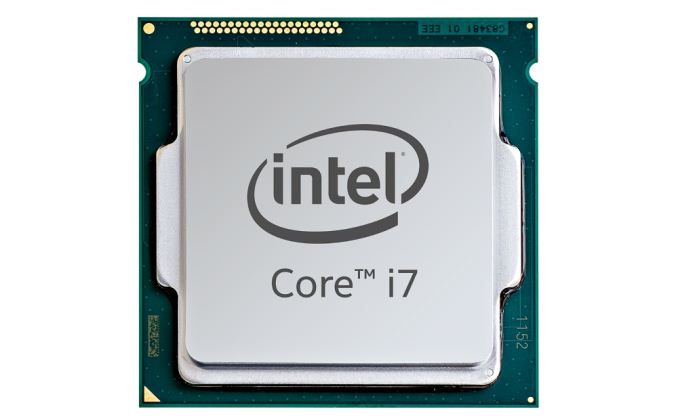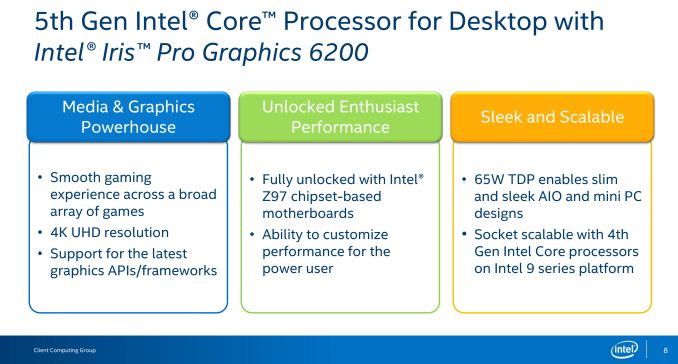The Intel Broadwell Desktop Review: Core i7-5775C and Core i5-5675C Tested (Part 1)
by Ian Cutress on June 2, 2015 7:45 AM ESTBroadwell-DT: Initial Thoughts
The new Broadwell desktop processors are somewhat out of sync with our regular expectations from Intel. Due to issues surrounding the 14nm node, as well as the cost, the whole Broadwell line from tablet to table-top has come out slower and more staggered than any Intel release in recent memory. As a result, the initial launch from Intel today is a pair of 65W desktop socketed models backed up with three 65W soldered down models whose true heritage is a chip primarily designed for large laptops and all-in-one devices.
Normally we would expect a range of desktop models from 35W up to 88W or higher, but socketed Broadwell-DT today only exhibits two units at 65W. This immediately puts a slight damper on those expecting to upgrade from Haswell’s high-end, or those wanting to go from something like a Pentium G3258 on Haswell to Broadwell’s top SKU. As a result, we have to keep our expectations in check – 65W should on paper perform nearly as well as an 88W part would, except it would be reduced by several hundred MHz. Meanwhile as these processors are also fully-unlocked and overclockable, we're left to ponder whether or not the stock frequencies actually matter in that case.
Due to the differential tangent at play, these processors also exhibit Intel’s best integrated graphics package, Iris Pro (GT3e), previously reserved only for soldered down/laptop/mini-PC orientations. This graphics package comes with largest number of execution units available from Intel, 48, alongside 128MB of eDRAM that acts almost like an L4 cache. This helps alleviate memory bandwidth pressure by providing a large(ish) pool near the CPU but with lower latency and much greater bandwidth than main memory. The eDRAM has the greatest effect in graphics, but we also saw some moderate increases in our non-3D regular benchmark suite.
The benefit of the graphics package, Iris Pro 6200, means that Broadwell-DT takes the crown as the fastest socketed graphics available. Our testing showed that the even the second-tier socketed SKU, the i5-5675C, outgunned the previous title holder, AMD’s A10-7870K. Despite having the i7-5775C in to test, due to time and firmware issues, we were unable to run the numbers on the integrated graphics but will do so in a later piece.
The key element to Broadwell-DT is not to consider it a natural successor to Haswell. It doesn't so much replace Haswell-K at this time, so much as it occupies a space Intel has left neglected since the launch of Haswell – the ultimate Intel integrated graphics solution. For users on integrated graphics, where money is no object, Intel now offers you the option to combine the regular CPU performance associated with Intel and a GPU that has the added performance benefits of on-chip, high-bandwidth eDRAM. The only question is whether that combined performance is worth the potential cost, and some would say no, pointing at a combined APU + GPU solution for equivalent or better gaming performance for the same price.
Pricing for the i5-5675C is listed as $276, slightly higher than the price of the i5-4690K which is at $236 on Amazon (reduced from $265). The i7-5775C is a bit higher at $366, also a margin higher than the i7-4790K which is $339 (reduced from $380). This makes Broadwell a tough sell right now in most circumstances unless you are absolutely limited to integrated graphics and want the best solution possible in a configurable PC. Given that Intel has also mentioned Skylake in their recent Computex keynote, it implements an abnormal situation that Intel has never been in with a new platform being talked about in the same breath. We have been told that these parts exist because users wanted them, and it has been interesting to see just how the added eDRAM changes the performance with discrete graphics in the mix.












196 Comments
View All Comments
Shadowmaster625 - Tuesday, June 2, 2015 - link
Wow so anyone who buys one of these chips is spending half their money on a useless GPU that cant even beat a lowly R7 250. That is $120 to $180 totally wasted on GPU, which occupies half the die. Talk about a massive intel tax. What happens if intel only offer a K version that contains half the die wasted by this useless GPU? How many people are going to just suck it up and buy it even though half the chip will never be used because they will be running a real graphics card?TEAMSWITCHER - Tuesday, June 2, 2015 - link
These chips really only make sense for high end laptops like the 2015 MacBook Pro - which ironically doesn't use them. It boggles my mind that Intel is shipping so many transistors that go completely unused. It's the antithesis of Moore's Law - Intel silicon is HALF-USELESS.PubFiction - Wednesday, July 1, 2015 - link
That's because intel only cares about mobile now, this stuff isn't made for us its hacked to work for desktop users this stuff is all about mobile. Personally I deal with largely because I am just happy that people who buy stuff like macbooks can now actually have a chance of running boot camp and playing games. In the mobile work igpus have always been a big part of the scene. Also the better intel does with integrated graphics the more they are able to kill AMD/NVidia which is what they really want to do, slowly and steadily eat the bottom end of the GPU market out from under them. It used to be that ANY discreet graphics on a laptop was WAYYYYY better than integrated. But after intels 2nd gen core series the bottom X1XX and X2XX gpus seemed to not make any sense, and intel has been getting better to the point now that X4XXX gpus are starting to not make sense. This screws graphics makers into only being able to sell higher end X5XX + GPUs and they destroys their bread and butter money.bill.rookard - Tuesday, June 2, 2015 - link
As much as I hate to say it, I agree. While their new iGPU is beating AMDs iGPU, the place where such iGPUs make sense is in small HTPC scenarios most of all (apart from budget gaming laptops which have a completely different thermal restriction). The kicker is though that the pricing is far too high for even being considered for what amounts to a media playback machine. It's thermally too hot for a laptop scenario.If they had paired up the iGPU with a G3258 CPU core set and the Crystalwell DRAM, and priced it near AMD's offerings, THAT would be a very compelling product.
Refuge - Tuesday, June 2, 2015 - link
I'd buy that.extide - Tuesday, June 2, 2015 - link
Uhhh, maybe you need your eyes checked, but it is beating the R7 240 in all except one of the benchmarks...MikhailT - Tuesday, June 2, 2015 - link
Dude, go re-read the graphs, Intel is beating R7 in almost all benchmarks.Namisecond - Wednesday, June 3, 2015 - link
Actually, the GPU takes up over 60% of the die space on the first chips, there is a 2nd piece of silicon comprising the EDRAM that take up a not-so-insignificant piece of real estate on the chip.The situation with AMD APUs are similar, about 40-45% of their die space is GPU. When they go HBM, they will in a similar situation to Intel, and they'll need to charge much higher price to make up for the tech.
If you want lowest cost/value for CPU, get a Pentium, particularly the anniversary edition. They're cheap (I can get them for about $50) You can overclock the shit out of them and their IGPU only takes up about 40% of their die space. If you need more CPU power in the Socket 1150 format, get a Xeon E3 which has no IGPU...they are cheaper than Core I7, but they cost more than core I5.
der - Tuesday, June 2, 2015 - link
Awesome stuff! Killer chipset!der - Tuesday, June 2, 2015 - link
50th comment!